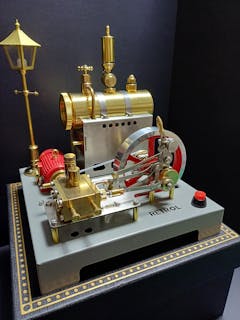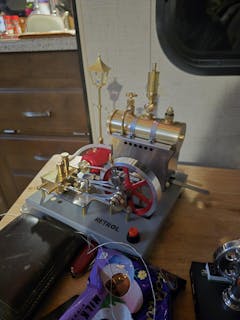Electromagnetic
Filters
Original price
$224.99
-
Original price
$224.99
Original price
$224.99
$224.99
-
$224.99
Current price
$224.99
| /
V8 Electromagnetic Engine 5V 4W 8 Coils V-Shaped Engine Model
Electromagnetic Engine 5V 4W 8 Coils High Speed V-Shaped Automobile Engine Model for Gift Collection An electromagnetic engine model can be used to...
View full details
Original price
$224.99
-
Original price
$224.99
Original price
$224.99
$224.99
-
$224.99
Current price
$224.99
| /
Save 0%
Save %
Original price
$359.99
-
Original price
$359.99
Original price
$359.99
$359.99
-
$359.99
Current price
$359.99
| /
V8 Electromagnetic Motor Engine 24V DIY Running Generator
V8 Electromagnetic Engine 24V Electromagnetic Motor DIY Runnable Generator for Science Project - EnginediyThe Electromagnetic Engine will replace t...
View full details
Original price
$359.99
-
Original price
$359.99
Original price
$359.99
$359.99
-
$359.99
Current price
$359.99
| /
Save 0%
Save %
An electric motor is a motor that converts electrical energy into mechanical energy. Most electric motors operate by the interaction between the magnetic field of the motor and the current in the windings, thereby producing force in the form of torque applied to the motor shaft. Generators are mechanically identical to electric motors, but operate with a reverse flow of power, converting mechanical energy into electrical energy.
Electric motors can be powered by a direct current (DC) source, such as a battery or rectifier, or by an alternating current (AC) source, such as a grid, inverter or generator.
Electric motors can be classified according to considerations such as type of power source, construction, application and type of motion output. They can be AC or DC powered, brushed or brushless, single-, two- or three-phase, axial or radial flux, and can be air-cooled or liquid-cooled.
Electric motors generate linear or rotational forces (torque) that are used to propel certain external mechanisms, such as fans or lifts. Electric motors are usually designed to rotate continuously, or to move linearly over a considerable distance compared to their size. Electromagnetic solenoids are also transducers that convert electrical energy into mechanical motion, but can only produce motion over a limited distance.
An electromagnetic motor is a machine that uses the magnetic force generated by the flowing electric current of a wire to power the motion of the motor. All electric motors operate according to the electromagnetic principle. Types of motors include alternating current (AC) motors and direct current (DC) motors. AC motors use wall currents and DC motors use batteries as a power source and magnetic force to rotate the motor. Electromagnetic motors are common in almost every home and are commonly found in popular household items such as fans, sink pumps, air conditioners, washing machines and electric toothbrushes.
Electric motors can be powered by a direct current (DC) source, such as a battery or rectifier, or by an alternating current (AC) source, such as a grid, inverter or generator.
Electric motors can be classified according to considerations such as type of power source, construction, application and type of motion output. They can be AC or DC powered, brushed or brushless, single-, two- or three-phase, axial or radial flux, and can be air-cooled or liquid-cooled.
Electric motors generate linear or rotational forces (torque) that are used to propel certain external mechanisms, such as fans or lifts. Electric motors are usually designed to rotate continuously, or to move linearly over a considerable distance compared to their size. Electromagnetic solenoids are also transducers that convert electrical energy into mechanical motion, but can only produce motion over a limited distance.
An electromagnetic motor is a machine that uses the magnetic force generated by the flowing electric current of a wire to power the motion of the motor. All electric motors operate according to the electromagnetic principle. Types of motors include alternating current (AC) motors and direct current (DC) motors. AC motors use wall currents and DC motors use batteries as a power source and magnetic force to rotate the motor. Electromagnetic motors are common in almost every home and are commonly found in popular household items such as fans, sink pumps, air conditioners, washing machines and electric toothbrushes.
Sort by









